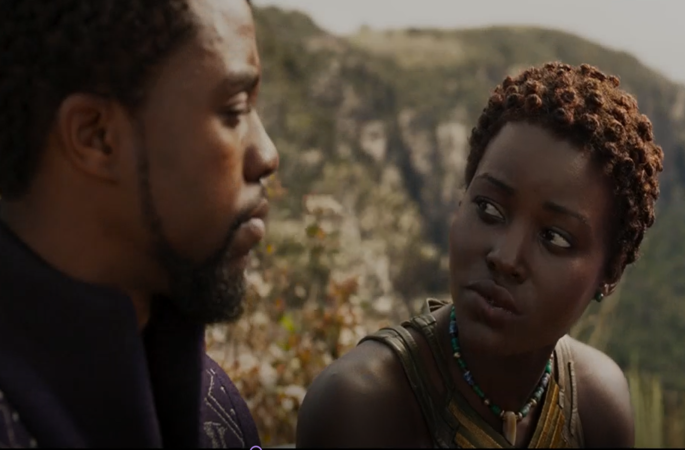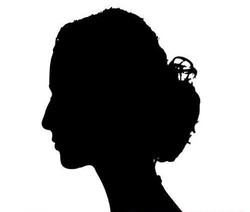Kevin Andrews says:
Fable.
Bedside tale.
The Lion King.
The opening scene of Black Panther is pregnant with these impressions. A mark of Marvel Studios’ strength is that their best movies almost always focus on superior storytelling. This is showcased in my favourite movies from their cinematic universe, as they enraptured me in the same way children are enthralled before they sleep and dream of the impossible.
Black Panther takes cues from African tradition and storytelling right from the establishing sequence, beginning with a masterful narration coupled with a unique visual aesthetic: the figures and locations emerge as living sand sculptures.
Its setting, style, and the incredible performance delivered by its actors combine to earn the nostalgic throwbacks it makes to legendary stories. To be clear, Black Panther does not ride on The Lion King’s coattails: both movies simply benefit enormously from the rich fabric of life and history that makes up the African continent. It pulls enormous strings tied to the continent’s history, particularly concerning slavery and oppression, and uses the stunning backdrop of Africa’s various cultures, fashions, rituals, and cuisines to proudly ground its audience.
Rich, vibrant, and sometimes even neon colours make up the visual aspect of this tale, set mostly in the fictional African nation of Wakanda. Despite being the most technologically advanced city on the planet, it shucks off the trappings of many minimalist-and-chrome, futuristic-seeking worlds portrayed in other contemporary works, choosing instead to represent the might and splendour of a nation that wove its heritage and traditions into the evolution brought about by technological progress.
Black Panther divests itself of other trappings as well. It is the first superhero movie since Blade (1998) to feature a person of colour in the lead role. In fact, it is much more: a blockbuster whose cast comprises almost exclusively people of colour. The titular character, T’Challa, played by Chadwick Boseman, is portrayed powerfully through multi-dimensional representation as a son, a king, and Wakanda’s guardian angel, particularly as he grapples with ideals concerning those whom he should or should not consider his people.
His younger sister Shuri (Letitia Wright) and his mother Ramonda (Angela Basset) are excellent in their supporting roles as loving family, but the real stars of the show are the Wakandan General Okoye (Danai Gurira) and the spy Nakia (Lupita Nyong’o).
Okoye is a force of personality and skill, backed by her unshakeable faith and perseverance in duty. Of all the characters in this film, she relies on tricks, technology, and superhuman abilities the least, preferring to act upon the fulcrum of her close-quarters combat skill and experience.
Nakia is another character that displays strong agency in Black Panther. While she plays T’Challa’s love interest, the romantic subplot is vastly superseded by her will to execute her job as effectively as possible, and to work for the betterment of all people. This comes up early on in the movie, when she tells T’Challa that she cannot stay in Wakanda because she is needed elsewhere. She too is a capable combatant in her own right, another warrior with noble bloodlines and strong cultural roots.
It must be said that Shuri also has the distinct markings of a character who is being set up for larger prominence in future movies or spin-offs. In the comics, the Princess has long wanted to become Wakanda’s first female Black Panther, and Wright’s portrayal of the character is both lovable and solid enough to make this a distinctly intriguing possibility. What’s more, it’s clear that the filmmakers have the sense to portray Shuri foremost by her personality and merit. An example of this is seen fairly early on in the movie, where she is referred to as “a child” during a heated monologue by M’Baku (Winston Duke), where other movies would refer disparagingly to a similar character as “a girl”.
Tied inextricably with Black Panther’s commentary on oppression is Erik Killmonger (Michael B Jordan), who can arguably be labelled the most engaging character of the movie, and the most compelling villain of every modern Marvel movie to date.
Killmonger shares some core beliefs with our heroes, but is set apart by the means he feels are necessary to make his vision a reality. It is also telling that his relationship to T’Challa means the two were separated only by the circumstances of their birth – one child born into wealth and power and trained to become a superhuman king, while the other was born into poverty and felt the sting of paternal loss early in life.
Killmonger, therefore, does what good comic book villains are supposed to do. He holds a mirror to our hero’s thoughts, ideals, doubts, strengths, and weaknesses, and tests T’Challa’s right to call himself the centre of our story. He is not the villain so much as he is what T’Challa may have been if his origin and circumstances of birth had been corrupted to the extent Killmonger’s had.
Black Panther‘s greatest feat is in how it makes you wonder that maybe, just maybe, the movie should have been called Killmonger instead.
Kevin Andrews is a lifelong fan of Spider-man’s antics, and now dissects the narratives and characterization within every Marvel and DC movie. He grew up in the Middle East, and is currently based in Sri Lanka.
Dulcinea Angelline says:
The images and sounds of the panorama on the screen imprint you: the thundering waterfall, with its strangely still, epicentered liquid dais, the graceful deadly warriors, glorying in their fierce skill, each person seen in the fullness of themselves, journeying to their own version of heroism, colliding in a vivid choreography.
The serrated fusions of tribalism and gang culture, of the powerful natural country and the CGI enhanced Cityscape, the giant metallic rhinos, the totem animals and the voodoo of the connecting rituals of life and transitional after-life. The vast, sun-scorched plains, the dark shapes in the trees. I loved the characters’ tactile and visceral affinity with their land. Watch for the joy in their faces when they see their country in its beauty and glory, as they come in on the plane from their mission in the outside world.
Other impressions: Wounds unto death, the hero who does not yield, the sassy kid sister with the mad tech skills, every stately woman a Queen. The ladies are impatient with restrictions and falsity: the General hates the fake wig and throws it like a weapon in combat at her pop-up enemy, and the kid sister disrupts the coronation ceremony when she complains that her corset is too tight. People thought at first she was contesting for the throne. No question that she is not a Princess, but a Queen. Her brother the Boy King with the lovely smile, his colours all on the inside at first, is tested as he should be, almost beyond our endurance.
All the colour and the wondrousness could not suppress a small question which has been growing in my mind since my first viewing. It is this. All these strong, fierce, archetypal women ultimately embraced wholly supportive roles: Mother, Sister, Lover, Warriors, Medicine ElderWoman, all surround him, at the periphery of his power, assisting the boy king to achieve his majesty.
Not one of these women felt ready to take her seat on the vacated throne; they felt the lack of an army, and sought help from another male tribal leader. They seemed to see themselves only as backup ancillary support. I hope true female power will emerge in the franchise to come, and that this ‘moment’ of fempowerment will become an era.
When I see it again, I will appreciate fully the crackling resonances of the colonial outrages underlying the dialogue, the slashing glances, the random humour, the furious tensions of competing sovereignties. The glowing purple flowers, horrifically burned by the failed contender at the height of his false glory, the one residual one saved and kept sacred by the girl who says ‘It is my duty to fight for what I love’. Who wants to ‘save her country, not just serve it’. But I also remember the heroic villain holding the elder woman by her throat in disrespect. This model of male violence contrasts with T’Challa, and his challenge ends in a watery grave.
Black Panther is great, but its portrayal of women is still a work in progress. I carry with me now these worlds within worlds. The way the waterfalls seem to flow upwards into space. My own eyes wet with tears I did not expect to shed.
Dulcinea Angelline is a movie buff and cultural commentator, currently based in Sri Lanka.




leave a comment